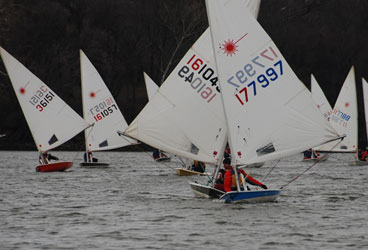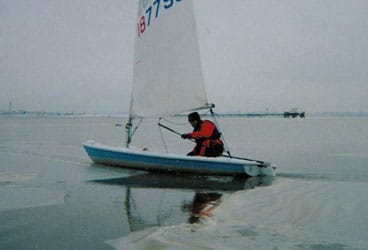When most people envision a perfect sailing scenario, they think of warm breezes and T-shirt weather. I like that, too, of course (you gotta go to Cabarete, if this is your ideal). And, sure, most of the sailing world right now is coming down off their warm Key West high, feeling all smug and superior. But increasingly, I am finding that the most fun I have sailing and racing my Laser is when the skies are gray, the air temps are cold, and there’s the possibility of snow.
Yep, there’s an excellent Laser frostbiting fleet here in Washington, D.C., courtesy of the Potomac River Sailing Association. They race just south of Reagan National Airport, on the river or in a shifty, flat-water cove that’s ideal for cold-weather sailing. I started racing with them a few years ago as a way to get outside on winter Sundays and make Laser-sailing a year-round thing. There are usually 15-20 Lasers racing, the competition is good and friendly, and the fleet is really well-organized. It’s everything you want, except, in theory, the cold weather. But now I find myself seduced by the sublime pleasure of winter sailing, too.

Of course, racing in cold weather in a small boat that goes upside down easily requires a slightly different approach. The fleet has a rule of thumb that if the wind speed exceeds the air temps, you think twice about sailing. Come to think of it, that rule would be REALLY wise to follow for anyone who sails in warm climes. And cold weather does sometimes prevent racing, as it did this past weekend, when ice sheets floated across the race course. The one guy who did go out still managed to have fun, and came up with some useful frostbiting rules of thumb: 1) Don’t sail into an ice field on an ebb tide—its ugly; 2) Set the sail at the dock to something you can live with—frozen control lines don’t move; 3) If you notice the RC boat has been hauled out, you might oughta head back to the dock.
The icy winter has also forced our frostbite fleet to resolve some difficult philosophical questions via the PRSA group e-mail list, such as: what kind of ice floes should be considered obstructions under the rules of sailing? I think the answer was black ice that would stop you short, as opposed to slushy, white ice you could potentially sail through, albeit slowly.

www.potomacriversailing.org
Obstruction?
But the truth is, while there might be a few weekends per winter that require a hefty dram of masochism paired with a hefty dram of post-race whiskey, frostbiting in Washington, D.C., rarely involves actual frost. Hats off to those fleets further north, on Long Island Sound, Narragansett Bay, and beyond. So, while your friends might be impressed with how tough and dedicated you are to the sport of sailing—and one of the pleasures of frostbiting is to NOT disabuse them of this view—the reality is you’re often enjoying spectacular, 50-degree days.
In any case, whatever the temperature, a dry suit combined with modern fleecy layers can keep you as warm as you like. I often find myself sweating and taking off my hat to cool down by letting the steam rise from my head. The only real cold-weather dilemma I grapple with, truth be told, is whether to sail with gloves or not, since I can never find gloves that give me the same line feel and grip as my bare hands. Last week, I sailed commando in 37 degrees, and it was fine, with my overheated core pumping lots of warm blood into my naked digits. Nor sure it would be as simple in Newport, R.I. The video below comes from a Patch.com story about Newport’s frostbiting scene.
The fun of frostbiting is much more than about being comfortable. I always have more fun when I’m doing something that most of the rest of the world thinks I shouldn’t be doing. And winter sailing has its own feel—the trees are bare, the wildlife is different, and there’s no traffic on the water. It’s stark, yet beautiful in its own way. And somehow the world closes in on you a bit, creating a special sphere of isolation in the wider winter world. Everything—the cold, hard gusts, the chilled spray, the diffused light of a winter-yellow sun—feels unique. Planes are landing overhead. You’re sharing a unique world with people who’re also happy to be out there. You’re sailing your Laser in January. You’re racing in a tight fleet. What could be better than that?
Maybe I’d feel different if I was frostbiting in Norway:









